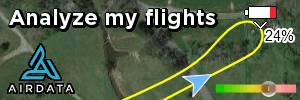As promised quite a while ago.
(assuming all datapoints are correct )
When taken a close look at the differences it clearly shows where the props would find their applications. The 3blade Carbon props give high-wind alarms for a reason: RPM's are low from front to back of their Characteristics. The material of the cheap chinese copies of the DJI 8331 stealth props cause them to bend at higher forces causing the respond to that being extreme high rpm's due to less and less lift. MAS props are a bit more rigid and show slightly lower rpm compared to the DJI 8331 originals. All with all an interesting comparison.
An interesting find is that the spread between Front motor RPM ( RPM_F ) and rear motor RPM ( RPM_B ) vary per propeller type and never show overlap. the most significant delta between Front and Back RPM is found on the cheap flexible chinese copy props, increasing almost exponentially at elevated Weight/RPM .
All possible variables that contribute to weight-changes ( Load ) have been defined as can be seen in the upper left corner of each sheet. The last sheet is just a combination of averaged data, extracted from the previous 4 to enable a quick comparison.
Any basic units like Current and Voltages were deliberately decoupled from the equation to keep things more general:
some tend to tune or tweak the driver responses like min/max currents or the PID response of their bird's motor drivers hence making this fit for general interpretation. The MPP is box-stock with the latest FW installed.
Looking forward to feedback or findings w r to the above characteristics or personal experiences.
T
Legenda:
RPM has been measured per Stroboscope.
RPM = Revolutions Per Minutes
RPM_F = RPM Front Propellers
RPM_B = RPM Back Propellers
RPM_AV= Averaged ((Front+Back)/2)
RPM_RC= RPM as read on Remote Control
Weight in Grams, added to COG of Craft.





(assuming all datapoints are correct )
When taken a close look at the differences it clearly shows where the props would find their applications. The 3blade Carbon props give high-wind alarms for a reason: RPM's are low from front to back of their Characteristics. The material of the cheap chinese copies of the DJI 8331 stealth props cause them to bend at higher forces causing the respond to that being extreme high rpm's due to less and less lift. MAS props are a bit more rigid and show slightly lower rpm compared to the DJI 8331 originals. All with all an interesting comparison.
An interesting find is that the spread between Front motor RPM ( RPM_F ) and rear motor RPM ( RPM_B ) vary per propeller type and never show overlap. the most significant delta between Front and Back RPM is found on the cheap flexible chinese copy props, increasing almost exponentially at elevated Weight/RPM .
All possible variables that contribute to weight-changes ( Load ) have been defined as can be seen in the upper left corner of each sheet. The last sheet is just a combination of averaged data, extracted from the previous 4 to enable a quick comparison.
Any basic units like Current and Voltages were deliberately decoupled from the equation to keep things more general:
some tend to tune or tweak the driver responses like min/max currents or the PID response of their bird's motor drivers hence making this fit for general interpretation. The MPP is box-stock with the latest FW installed.
Looking forward to feedback or findings w r to the above characteristics or personal experiences.
T
Legenda:
RPM has been measured per Stroboscope.
RPM = Revolutions Per Minutes
RPM_F = RPM Front Propellers
RPM_B = RPM Back Propellers
RPM_AV= Averaged ((Front+Back)/2)
RPM_RC= RPM as read on Remote Control
Weight in Grams, added to COG of Craft.





Last edited:









